
Harnessing Behavioral Insights: Proven Strategies for Influencing Consumer Behavior
Introduction
In today’s hyper-competitive marketplace, understanding consumer behavior is more crucial than ever. As businesses strive to connect with their customers, the key to unlocking engagement, loyalty, and conversions lies in Harnessing Behavioral Insights: Strategies for Influencing Consumer Behavior. This article will delve deep into the psychology behind decision-making, explore effective behavioral strategies, and provide actionable insights that can help your brand thrive.
With the rise of digital marketing and the ever-increasing volume of data available, companies have a wealth of opportunities to understand their customers better. However, merely collecting data isn’t enough. The extraordinary potential of behavioral insights must be grasped and strategically exploited to instigate real change. This article uncovers how you can create a powerful synergy between behavioral insights and marketing strategies to forge lasting consumer relationships.
The Psychology of Choice: Understanding Consumer Behavior
When discussing Harnessing Behavioral Insights: Strategies for Influencing Consumer Behavior, it’s essential to explore the psychological factors that guide consumers in their decision-making processes. The insights derived from behavioral economics reveal that consumers often operate on heuristics—mental shortcuts influenced by their emotions, social norms, and cognitive biases.
Cognitive Biases That Impact Decisions
- Anchoring Effect: Consumers often rely heavily on the first piece of information they encounter, which serves as an anchor for subsequent decisions.
- Loss Aversion: The fear of losing something is often more powerful than the pleasure derived from gaining something of equal value.
- Chunking: Breaking down complex information into smaller, manageable chunks can enhance understanding and retention.
Table 1: Common Cognitive Biases and Their Impacts on Consumer Decision-Making
| Cognitive Bias | Description | Example in Marketing |
|---|---|---|
| Anchoring Effect | Relying on the first piece of information seen | Introducing a high-priced item first to make others seem reasonable. |
| Loss Aversion | Preference to avoid losses over acquiring gains | Offering a "limited time" discount, emphasizing what might be lost. |
| Chunking | Presenting information in smaller, digestible pieces | Using bullet points for product features. |
Leveraging Behavioral Insights for Effective Marketing
To effectively influence consumer behavior, brands must align their marketing strategies with these psychological insights. Here are some proven techniques rooted in behavioral science.
1. The Power of Social Proof
Humans are inherently social creatures who look to others for guidance. Tapping into social proof can drastically alter consumer behavior. This can be harnessed through testimonials, user-generated content, and influencer collaborations.
Case Study: Airbnb
Airbnb incorporates social proof by displaying reviews prominently. By highlighting positive testimonials, potential guests are more likely to trust the service and make reservations. The integration of social proof is a clear example of Harnessing Behavioral Insights: Strategies for Influencing Consumer Behavior to drive conversions.
2. The Scarcity Principle
Creating a sense of urgency or scarcity can motivate consumers to act swiftly. When individuals believe that an opportunity may vanish, they tend to value it more highly.
Case Study: Amazon
Amazon frequently employs scarcity tactics by noting when stock is low or creating "flash sales." This approach capitalizes on the fear of missing out (FOMO) and effectively drives consumers to make immediate purchases.
3. Personalization and Customization
Tailoring experiences to individual preferences is a game-changer. Personalization fosters consumer loyalty and satisfaction.
Chart 1: Impact of Personalization on Consumer Behavior
| Personalization Vendor | Increase in Conversion Rate (%) | Improved Customer Retention (%) |
|---|---|---|
| Retail Brand A | 25 | 15 |
| Online Service B | 30 | 20 |
Case Study: Netflix
Netflix uses sophisticated algorithms to suggest content based on user behavior and preferences. This personalized experience enhances user engagement and retention rates, reinforcing Harnessing Behavioral Insights: Strategies for Influencing Consumer Behavior effectively.
4. The Endowment Effect
People place a higher value on things merely because they own them. Businesses can utilize this to encourage trials or offer free samples, making consumers feel a sense of ownership.
Case Study: Freetrade
Freetrade, an investment app, allows users to conduct trades without fees for a limited time. This strategy effectively enhances user experience while instilling a sense of ownership before converting users into paying customers.
Designing the Path to Purchase
Creating an optimal shopping experience can significantly influence consumer behavior. A seamless path to purchase navigates through their preferences, pain points, and motivations.
1. Simplicity in Design
A clutter-free interface can reduce cognitive overload. Simplifying choices makes the buying process easier and more enjoyable.
2. Clear Calls to Action
Your "call to action" (CTA) should be straightforward and compelling. Utilize actionable language and design cues to guide consumers toward favorable actions.
3. Trust Signals
Displaying certifications, security badges, and user-generated content can alleviate potential concerns about safety and reliability, further solidifying the consumer’s decision-making process.
Conclusion
The art of Harnessing Behavioral Insights: Strategies for Influencing Consumer Behavior is both an exciting and complex endeavor. By understanding the psychological principles at play, businesses can create impactful marketing strategies that resonate with their target audience.
The key takeaway? Leverage insights from cognitive biases and consumer psychology to craft experiences that engage, convert, and retain customers. As you apply these strategies, remember to continuously evaluate, adapt, and optimize based on consumer feedback and behavioral data.
FAQs
1. What are behavioral insights?
Behavioral insights refer to the understanding of the psychological, social, and emotional factors that influence consumers’ choices and behaviors. These insights are derived from disciplines such as behavioral economics and psychology.
2. How can I begin implementing behavioral strategies in my marketing?
Start by analyzing your target audience’s behaviors and preferences. Test various strategies, like social proof or personalization, to see what resonates best with your audience.
3. Can these strategies work for any industry?
Yes, Harnessing Behavioral Insights: Strategies for Influencing Consumer Behavior can be tailored to suit any industry. The key is to adapt the insights to align with specific consumer needs and market dynamics.
4. What tools can help me gather behavioral insights?
Analytics tools, customer feedback surveys, social media listening tools, and A/B testing platforms can help gather and analyze behavioral insights effectively.
5. How can I measure the success of these strategies?
Monitor key metrics such as conversion rates, customer retention, engagement levels, and sales growth to evaluate the effectiveness of your behavioral strategies.
This in-depth exploration aims to equip you with practical knowledge and insights, urging you to embrace the extraordinary power of behavioral insights in transforming consumer behavior. The world is rife with opportunities—seize them by cultivating a deep understanding of those you aim to serve!

















